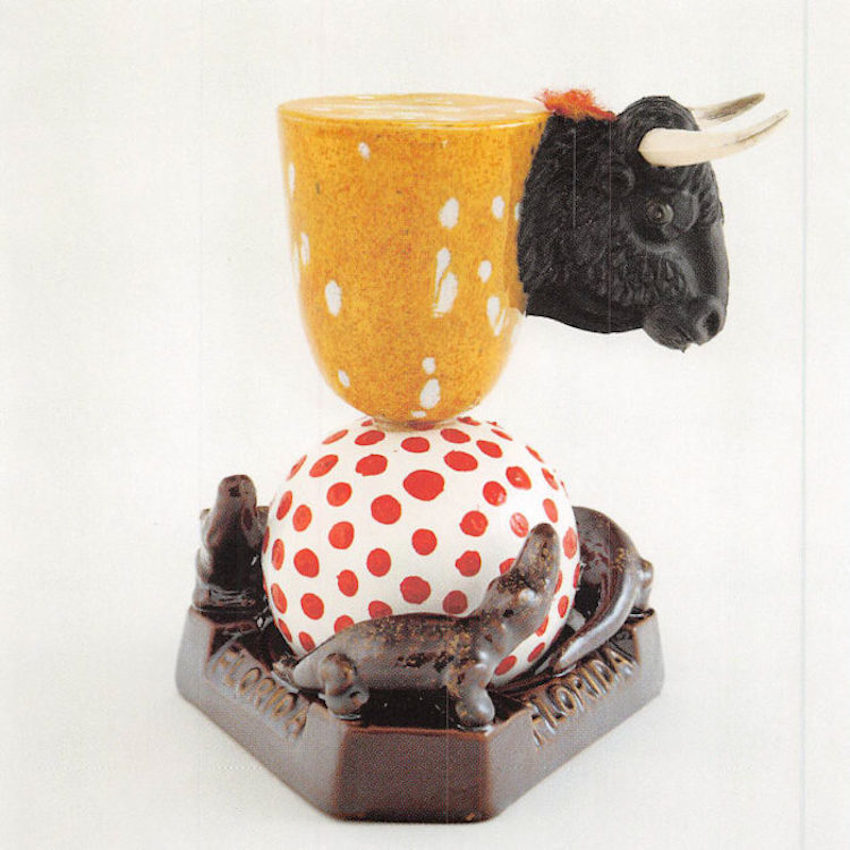We are extremely grateful to ceramic legend Léopold Foulem for allowing us to digitalize two of his incredible catalogs, “Phantasses” et soucoupes and Abstractions très Singulierès. As of today, both of these historic catalogs are available in cfile.library. If you are already a member, view the catalogs, or begin your 14-day free trial.
 “Phantasses” et soucoupes: Ceramics By Léopold L. Foulem
“Phantasses” et soucoupes: Ceramics By Léopold L. Foulem
Montreal: Saint-Laurent Art Museum, 2000
Bourassa, Paul
Translated in English, French
46 Pages
Both catalogs represent different stages in Foulem’s life’s work. In “Phantasses” et soucoupes, the Canadian artist assembles bricolage cups and saucers using found objects. The most important part of a cup and saucer is the part which we touch, the handle. Foulem’s handles are the most outrageous and sensual part of his assemblages: a plastic bull, a baby doll arm, buffalo, moose and bird figurines.
Click to Download your FREE Léopold L. Foulem Catalog
“All the implicit and mental acts of manipulation, the sacrilege of touching is consecrated on the handle where, depending on the piece the hand would be directed to a cherub tossing flowers, a globe, a shard… Some of these objects purport various symbolic meanings: love, sexual potency and possession. The spirit in which the observer who looks at these objects and thinks about handling them and bringing them to his mouth is overwhelmed by emotion — by fantasy.”
–Paul Bourassa, Curator of Decorative Arts, Museum of Quebec.
Essayist Paul Bourassa makes clear that art history from a great deal of eras is implicit to these objects. Marcel Duchamp’s ready-made object and the incorporation of the mundane into art. Next, Foulem’s use of miscellaneous, but strangely familiar objects points to Pop-Art and the Nouveau Realistes’ ideas about the overflow of industrialism and consumer products appearing in art as a byproduct of American consumerism. This is particularly relevant when the viewer is wondering about the objects’ provenance, or why the objects exist in the first place. Then, of course, the application of kitsch— decadence and degradation, which “aims to confront us with our own pretensions when it comes to taste.”
Léopold Foulem: Abstractions très Singulierès
Quebec: Éditions Materia, 2002
Mathieu, Paul
Translated in French, English
34 Pages
In Foulem’s Abstractions très Singulierès, which Paul Mathieu called “probably his most radical act yet,” the artist’s skill shines, as well as his eye for concept. The vessels, which are thrown seamlessly as if production-made, are attached to bases as sculptures are; all of their openings are sealed. The vessels are made to look archetypal; like something out of a decorative art history textbook–made with obvious technical skill, but run-of-the-mill. The surface’s designs derive from Chinese pottery.
“In itself, the joining of a familiar object to another form is not a radical act. If we were in the realm of sculpture (are we?), this state of affairs would be familiar, expected. Traditionally sculptures are presented on a plinth, and often physically attached to that base, which may, or may not be made of the same material, but this is rarely the case for vessels. ”
—Paul Mathieu, Artist
Don’t miss the in-depth essays in these catalogs by great ceramic thinkers Paul Bourassa and Paul Mathieu.
We are extremely grateful to ceramic legend Léopold Foulem for allowing us to digitalize two of his incredible catalogs, “Phantasses” et soucoupes and Abstractions très Singulierès. As of today, both of these historic catalogs are available in cfile.library. If you are already a member, view the catalogs, or begin your 14-day free trial.






Add your valued opinion to this post.